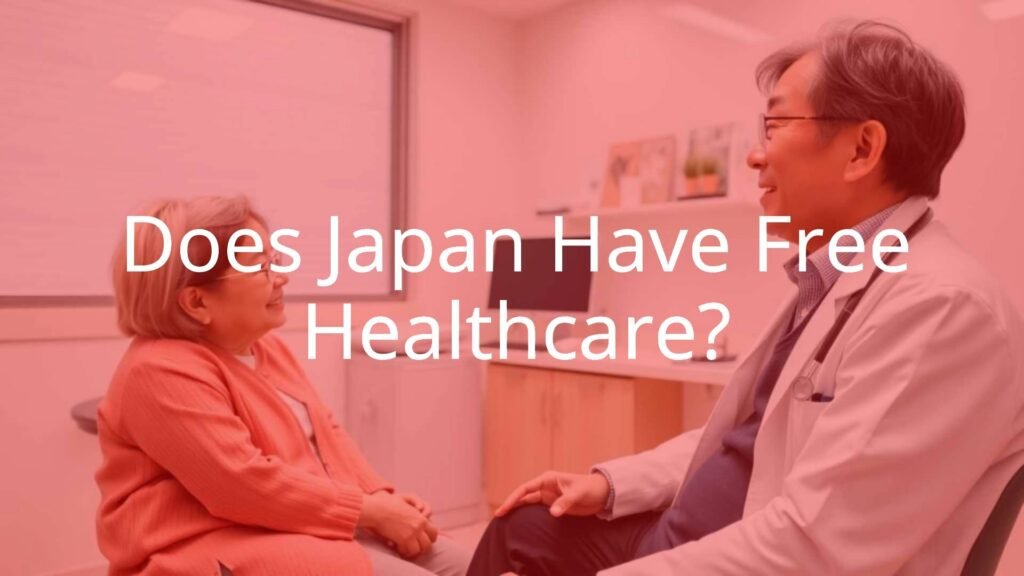Japan is known for its healthcare system, which is well-regarded around the world for its quality, easy access, and its role in helping Japanese people live long lives. However, a common misunderstanding is that healthcare in Japan is completely “free.” The simple answer is no – healthcare in Japan is not totally free. Instead, Japan has a universal healthcare system that covers most costs, making health services much more affordable for residents.

This system aims to treat everyone equally and to give almost all citizens and long-term residents access to good medical care without heavy financial stress. But patients still pay a part of their medical bills in the form of co-payments, monthly insurance premiums, and out-of-pocket expenses. These payments depend on a person’s income, age, and the healthcare services they use.
What Does ‘Free Healthcare’ Mean in Japan?
When people use the term “free healthcare” for Japan, they might believe that people do not pay anything when visiting a doctor or hospital. In fact, that’s not the case in Japan. Instead, Japan offers universal health insurance, where most medical expenses are paid through government taxes and required contributions from individuals. While patients still pay some fees, these are much lower than in many other countries.
Japan’s government promises citizens the right to health, which has led to universal health coverage since 1961. With this system, essential medical services are available and affordable to nearly everyone, regardless of how much money they make. Japan also focuses on preventing illness, which helps explain its long average life expectancy.
Is Healthcare Fully Free or Subsidized?
Healthcare in Japan is subsidized, not entirely free. The public health insurance system (Social Health Insurance, or SHI) usually pays about 70% of most medical costs, once monthly premiums are covered. Patients pay the remaining 30%. Some groups pay less: young children under three pay 20%, and low-income seniors over age 70 pay 10%.
To keep healthcare affordable, there are limits on how much people have to pay each month and each year, based on their income and age. For example, a working-age adult’s maximum monthly payment is about JPY 90,000 (around $724 USD). Tax deductions can help reduce the impact of high medical bills even more. Overall, the system protects people from very high healthcare costs.
Universal Health Coverage in Japan
Universal health coverage is one of Japan’s main social policies. All citizens and non-citizen residents who stay in Japan for at least three months must join a health insurance plan. The plans cover hospital care, general and specialist doctor visits, mental health, prescription drugs, home care, and many dental services. Services like physical therapy and some alternative treatments from registered centers are included as well.
About 98.3% of people in Japan are covered by work-based or resident-based health plans. The other 1.7% (those with very low incomes) are covered by Public Social Assistance, which does not require any payments from the patient. Because of this, health insurance in Japan covers nearly all treatments for the entire population, keeping care affordable and fair for everyone.

How the Japanese Healthcare System Works
Japan has a public health system that involves both government and private providers. Unlike some countries where health services are controlled only by the central government, Japan lets its 47 regions (prefectures) run a lot of the health services themselves. This means local authorities can decide what their people need most, including regular health services or nursing care for the elderly.
The national government still keeps a close watch, setting the prices for most medical treatments and giving money to the local governments, insurance funds, and care providers. Every two years, a government committee with doctors checks and updates the fee schedule, which helps control costs and discourage dishonest billing.

Structure of National Health Insurance and Employees’ Health Insurance
- Employment-based plans (Social Health Insurance, SHI): These cover about 59% of people – mostly full-time workers at medium or large companies and their families. The employee and employer each pay about half the insurance premium (roughly 5% of the employee’s pay).
- Residence-based plans (National Health Insurance, NHI): About 27% of people are covered under NHI, such as those who work for small businesses, are self-employed, or are without work. Premiums are based on income and are paid directly. Most foreign workers and digital nomads in Japan use this plan.
There’s also a special insurance plan for adults 75 and older, covering about 12.7% of residents, funded by pension deductions, government funds, and other insurance schemes.

Who Is Eligible for Public Health Insurance?
Japan’s health insurance is open to all citizens and people living in Japan for more than three months, including foreigners. Everyone has to join. Enrolling in the system can sometimes take a while for newcomers, so many foreigners get private health insurance to cover that period.
Once registered, you get a health insurance card and can use the public system. Tourists and short-term visitors can’t join, but everyone else who lives and works in Japan can. This policy helps everyone have a chance at good health and healthcare, regardless of background.
What Costs Are Involved for Patients in Japan?
Even though Japan helps with most medical costs, patients still pay part of their bills. This system keeps care affordable and helps people use services thoughtfully, while still making sure that almost no one has to cover big health costs alone.
Patients pay three types of costs: co-payments, monthly premiums, and out-of-pocket limits. These are structured to make sure that most people can afford care, especially those with long-term illnesses or smaller incomes.
Copayments, Premiums, and Out-of-Pocket Expenses
In general, patients pay about 30% of their medical charges when seeing a doctor or going to the hospital. The percentage is lower for children under 3 (20%) and for lower-income seniors over 70 (10%). Besides this, everyone must pay monthly premiums – taken from paychecks for employees and paid directly by those on residence-based plans.
Japan sets monthly and yearly caps on what people pay out-of-pocket. If your medical costs go above this amount, you get reimbursed. For working-age adults, the average monthly cap is about JPY 90,000. For people with lower incomes, the cap is about JPY 35,400. The annual family out-of-pocket maximum ranges from JPY 340,000 to JPY 2.12 million, depending on age and income. Payments above this limit are refunded.
What Is Covered by Insurance?
- Hospitalization and surgery
- Doctor visits (primary and specialist)
- Mental health treatment
- Most prescription drugs
- Most dental work
- Home healthcare and hospice
- Physical therapy
- Durable medical gear, if a doctor prescribes it (e.g., oxygen equipment)
Maternity care (prenatal checkups and child delivery) isn’t usually covered, but a lump-sum payment is given for childbirth. Some checkups for pregnant women are covered by local governments. Insurance also pays for certain preventive services like health education and screenings.

Extra Costs for Non-Covered Services and Medications
Some services and items aren’t covered by public insurance, which means patients pay the full amount themselves. For example, glasses for adults or non-prescribed optometry services aren’t covered unless a doctor requires them for children under nine. Private health insurance is common-over 70% of Japanese people have it. Private insurance is mainly used for cash benefits if you’re sick or to pay for elective or cosmetic procedures, which the public system does not cover. If you want care that’s not medically needed, new experimental treatments, late-night visits, or long hospital stays of over 180 days at big hospitals without a doctor’s referral, you’ll need to pay extra.
Pros and Cons of the Japanese Healthcare System
Japan’s healthcare often gets praise for its efficiency, low costs, and the good results it provides. But just like any system, there are both advantages and downsides. These help us understand both why the Japanese live so long and what issues the healthcare system still has to face, especially with an older population.
Benefits of Japan’s Approach to Healthcare
- Almost everyone has insurance and can get medical care, no matter how much money they make.
- Medical care is high quality, with modern technology and a strong focus on prevention, including vaccines and regular checkups.
- Out-of-pocket costs are controlled and capped, so most people can afford care.
- Patients can see specialists directly, often without a referral.
- Prices and services are regularly reviewed by the government, keeping the system current with economic and medical changes.
- The system helps people live longer: men in Japan live on average to 81, women to 87.
Challenges and Limitations of the System
- Mental health care is weak: basic psychiatric care is included, but general counseling is not, and there are outdated practices like isolation.
- There is stigma around mental health, so people may avoid treatment.
- Japan’s aging population is putting pressure on health and elder care services. Nearly 40% of Japanese people could be 65 or older by 2050.
- The “free access” model makes it easy for people to visit any hospital they choose, which sometimes crowds emergency rooms with non-urgent cases and causes long wait times.
- Language can be a problem for non-Japanese speakers because most hospitals don’t have English-speaking staff, even in cities.
- Most hospitals are privately run (about 85%), so making big changes across the system can be hard since each hospital manages itself and Must compete for patients.

Key Points About Healthcare Costs in Japan
Looking at healthcare costs in Japan, it’s clear that the focus is on fair access and keeping care affordable, not on being totally “free.” The government and required insurance payments cover most costs, while patients pay a share-usually about 30%. For small children and poor seniors, this share is even less.
Monthly and yearly payment limits keep medical bills from getting out of control and help protect everyone from high expenses. Many people also get extra private insurance for more peace of mind, but it’s mostly for extra cash while sick rather than gaps in basic services.
| Type of Cost | Standard Rate | Special/Reduced Rate |
|---|---|---|
| Co-payment | 30% | 20% (under 3 years), 10% (low-income 70+) |
| Monthly Out-of-Pocket Cap (Adults) | JPY 90,000 | JPY 35,400 (low-income) |
| Health Services Covered | Most medical, hospital, mental health, prescription drugs, dental, home care | |
| Excluded Services | Elective/cosmetic procedures, adult optometry, experimental treatments, long hospital stays without referral | |
Foreigners living in Japan should be aware of the steps to join the health system and the chance of needing to find an interpreter if they don’t speak Japanese. Japan’s approach shows how a balance between shared costs and government support can lead to high-quality care and long, healthy lives, all while not forcing people to pay sky-high medical bills. The system is designed so everyone contributes for the benefit of all, not to make care entirely cost-free.
- What Is a Maiko? - July 13, 2025
- What Does Domo Arigato Mean? - July 12, 2025
- What Does Naruto Mean? - July 12, 2025









